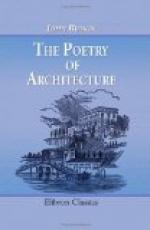29. The next point of interest is the window. The modern Italian is completely owl-like in his habits. All the daytime he lies idle and inert; but during the night he is all activity, but it is mere activity of inoccupation. Idleness, partly induced by the temperature of the climate, and partly consequent on the decaying prosperity of the nation, leaves indications of its influence on all his undertakings. He prefers patching up a ruin to building a house; he raises shops and hovels, the abodes of inactive, vegetating, brutish poverty, under the protection of aged and ruined, yet stalwart, arches of the Roman amphitheater; and the habitations of the lower orders frequently present traces of ornament and stability of material evidently belonging to the remains of a prouder edifice. This is the case sometimes to such a degree as, in another country, would be disagreeable from its impropriety; but, in Italy, it corresponds with the general prominence of the features of a past age, and is always beautiful. Thus, the eye rests with delight on the broken moldings of the windows, and the sculptured capitals of the corner columns, contrasted, as they are, the one with the glassless blackness within, the other with the ragged and dirty confusion of drapery around. The Italian window, in general, is a mere hole in the thick wall, always well proportioned; occasionally arched at the top, sometimes with the addition of a little rich ornament: seldom, if ever, having any casement or glass, but filled up with any bit of striped or colored cloth, which may have the slightest chance of deceiving the distant observer into the belief that it is a legitimate blind. This keeps off the sun, and allows a free circulation of air, which is the great object. When it is absent, the window becomes a mere black hole, having much




